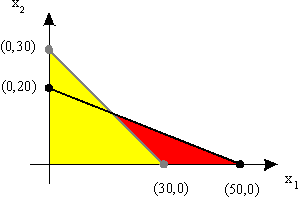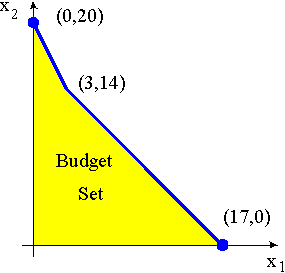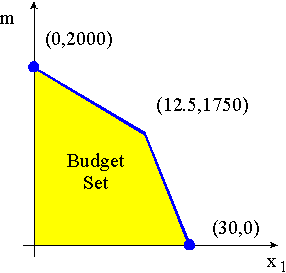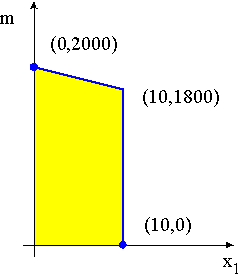Econ 302: Solutions for Questions about the Budget Set

- The budget constraint is given by 4x1+10x2=<200.
- Thus,
the budget line is given by
4x1+10x2=200. The intercepts are (50,0) and
(0,20).
The slope is -p1/p2=4/10=0.4. (dark line in the graph). - The budget set is the area underneath the budget line (red + yellow area excluding the yellow triangle on the top).
- The new budget line is 10x1+10x2=300.
- The intercepts are (30,0) and
(0,30).
The slope is -p1/p2=-1 (grey line in the graph). - The new budget set is the yellow area in the graph.
Question 2: The budget line is given by 2x1+4x2+10x3=49. Since x1=2, this reduces to 4x2+10x3=45. Because the consumer purchases twice as many units of good 2 than of good 3, the equation x2=2x3 must hold. Thus, substitute 2x3 for x2 in the equation 4x2+10x3=45 to get x3=2.5. Therefore, x2=5. Consequently, the consumption bundle is (2,5,2.5).

- If consumption of good 1 is 0 then all money is available for consumption of other goods. Thus, the vertical intercept is (0,20).
- Purchasing three units of good 1 costs 6 Dollars. Thus, 14 Dollars are left, and we get (3,14).
- Every additional unit costs 1 Dollar. If the remaining 14 Dollars are spent on cereal, 14 boxes (in addition to the 3) can be purchased. Thus, the horizontal intercept is (17,0).
- The budget set is indicated by the yellow area. The budget line is the blue line in the graph.
- The slopes are -2 and -1, respectively.

- Similar to the previous question, the vertical intercept is (0,2000).
- If the insurance covers 80% of the cost, then this means that per unit, the insurance company pays 80 Dollars and the consumer pays 20 Dollars. The company only pays up to 1000 Dollars. Thus, we must find the value x1 for which 80x1=1000. Therefore x1=12.5.
- Up to x1=12.5 the consumer faces a price of 20 Dollars per unit. Purchasing 12.5 units therefore costs 250 Dollars. This reduces consumption of other goods (measured in Dollars) from 2000 to 1750. Therefore we get (12.5,1750).
- If x1>12.5 the consumer faces a price of 100 Dollars per units. Since there are 1750 Dollars left, 17.5 additional units can be purchased. Thus, the intercept is (30,0).
- The budget set is indicated by the yellow area. The budget line is the blue line in the graph.
- The slopes are -20 and -100, respectively.
- The graph can be seen below.
